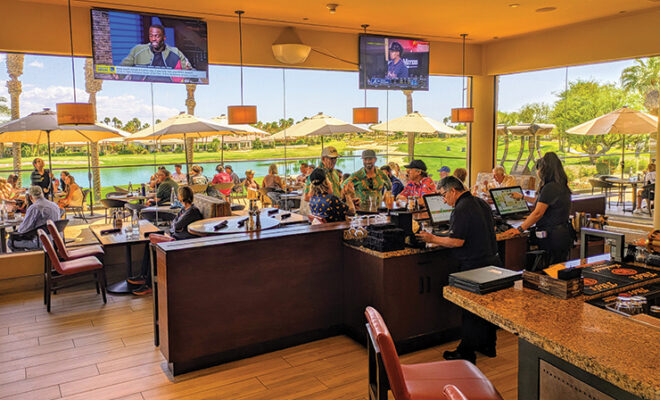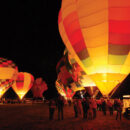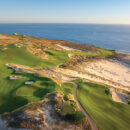LOFTY STAGE
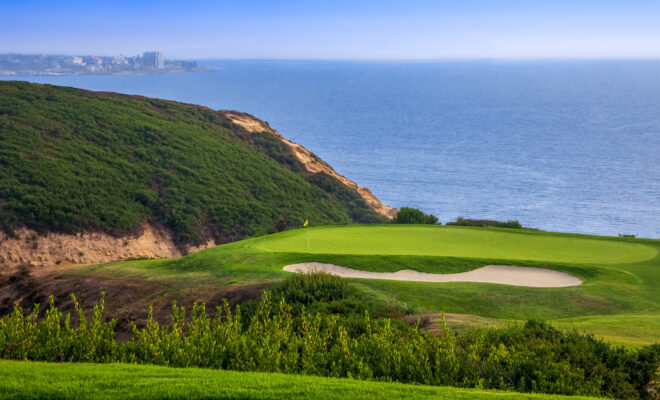

From a World War II Army base to becoming one of the most-revered golf venues in the world, the true Torrey Pines is one few people know.
On a weekend day in January of 1956, a crowd of nearly 30,000 gathered on the Torrey Pines Mesa above the Pacific Ocean for one of San Diego’s most popular sporting events of the era. Hushed galleries for golf? Nope. More like the roar of racing engines.
At Torrey in the 1950s, professional sports car drivers came to love a 2.7-mile road course fashioned on the streets of a former World War II Army camp now occupied by the Torrey Pines golf courses. Legendary competitors put the Torrey Pines Road Races on the map, and there was chatter that an “Indianapolis Motor Speedway of the West” could come to fruition.
The San Diego City Council had other ideas. It saw golf, not motorsports, as the best potential money maker. That broke the hearts of race fans, which is why they gathered en masse in early ’56 to see their final race and say goodbye. Incredibly, only 18 months later, the Torrey Pines South Course opened with a ceremony in which the then-mayor whiffed on his very first swing.
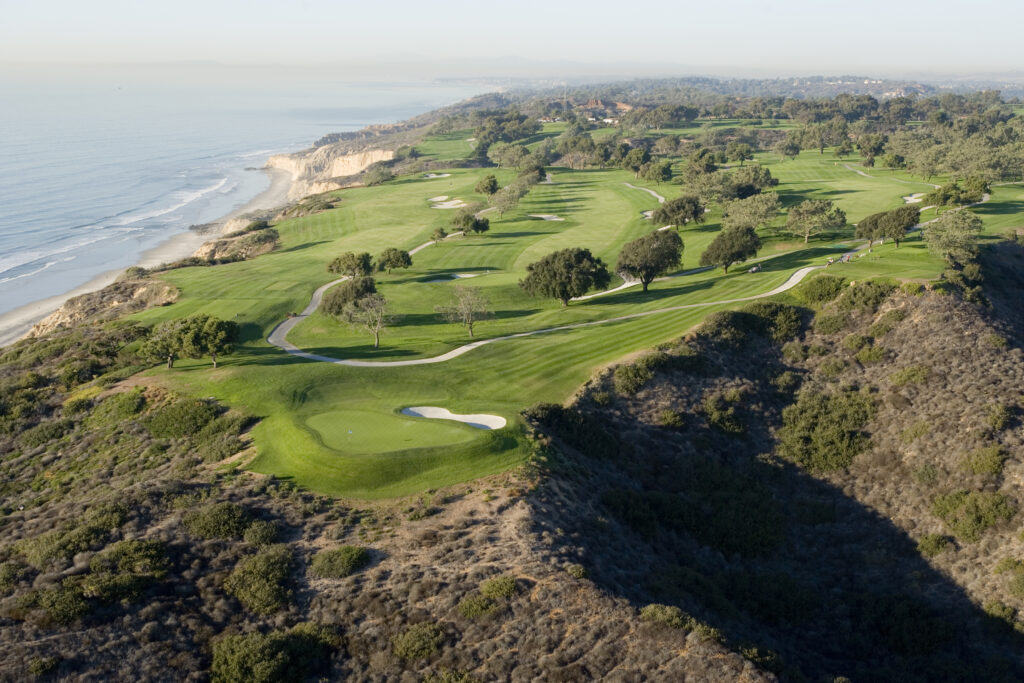
THE RIGHT CALL
Sixty-eight years later, it sure feels like San Diego made the right call. Simply put, there are no other municipal facilities in America, or the world, that are better recognized than those at Torrey Pines.
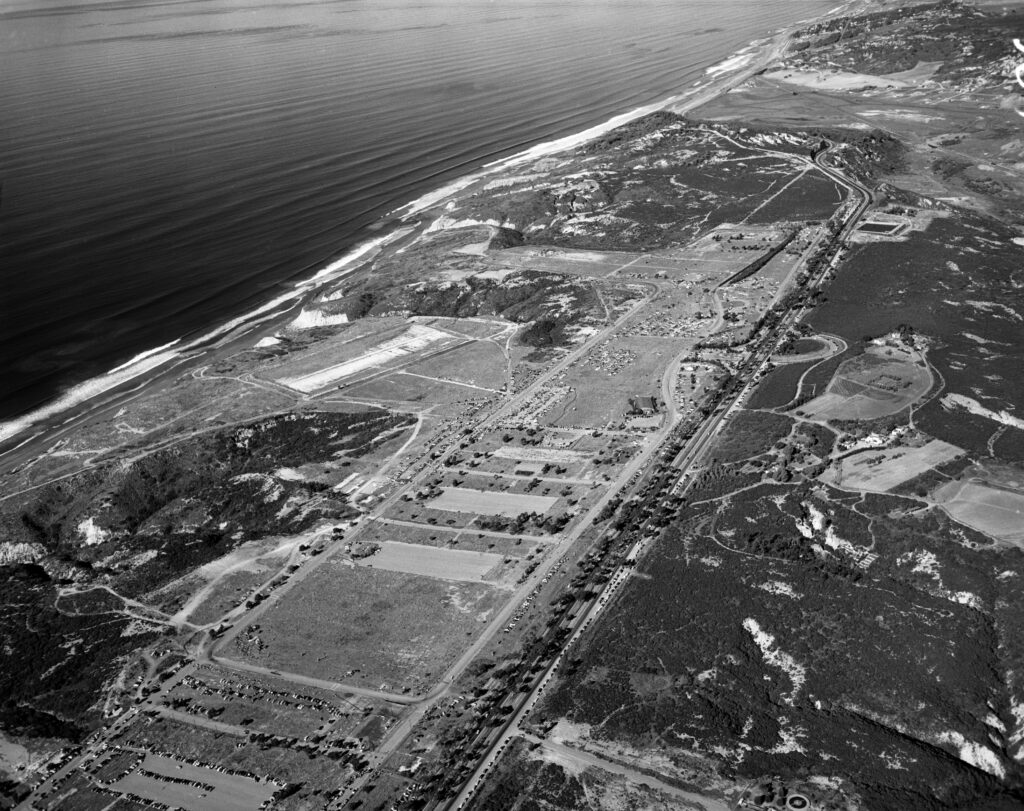
Torrey Pines Race Track, seen here in 1952 looking south to north, was a 2.7-mile course that held events from 1951 to 1956 and sometimes drew crowds of 35,000. Opposite left: present-day Torrey Pines Golf Course, from a similar directional vantage point.
The North and South courses host more than 150,000 rounds combined per year and earn millions in profits for the city’s Golf Enterprise Fund. The layouts, with their stunning views both on the ground and from blimps and drones, are featured for hours a day each January when the PGA Tour arrives for the Farmers Insurance Open.
With a little help from Tiger Woods and his eight pro victories on the property, as well as two U.S. Opens hosted, a bucket-list thirst from tourist players has become almost insatiable.
“Woods fell in love with Torrey Pines when his father took him to his first PGA Tour event there, and his first victory on the grounds came in the Junior World Championships”
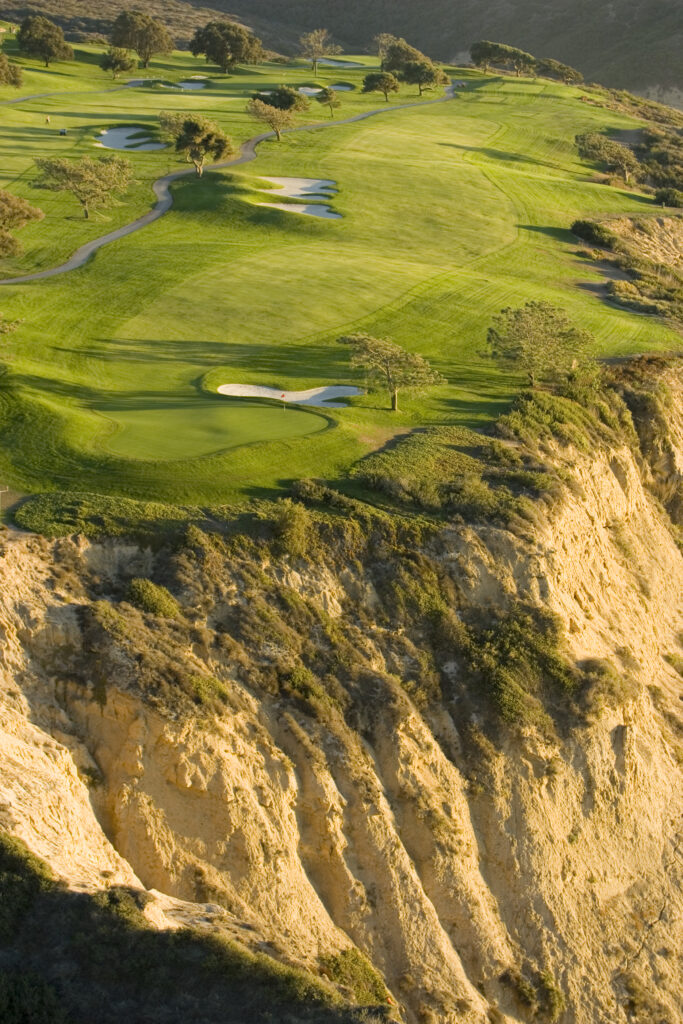
During the summer of 2025, Torrey Pines will continue its six decades of hosting some of the finest up-and-coming players in the Junior World Championships and then prepare for an unprecedented double for the course, when the 126th SCGA Amateur Championship and 11th SCGA Women’s Amateur Championship are played concurrently, July 28-31.
There will be competitors highly familiar with Torrey Pines and others who might be playing or visiting for the first time. Most will know the basics of the property, but there are so many layers to experience in La Jolla that it’s worth sharing some of the lesser-known tidbits and reminders of what makes the courses and the surrounding area so special.
WORLD WAR II HISTORY
At the current main entrance to the golf courses is the upscale Lodge at Torrey Pines, its early California craftsman style perfect for the setting. Now picture the hustle and bustle of basically a full city that extended to the cliffs, and that’s what the mesa looked like for much of the 1940s.
As World War II raged, the Army, fearing attacks on the West Coast by Japan, needed an anti-aircraft training base for new troops and leased much of the 1,162 acres on the mesa from the city for $1 per year. The base was called Camp Callan, and it ended up being the home to 40,000 troops who came for three-month training cycles.
At its peak, the post had close to 300 buildings, including a hospital, five churches and three theaters, and covered 23 blocks. It also had a “driving range” of sorts, with the Air Corps using planes to tow targets over the ocean for the base’s 90-millimeter guns to fire on. The South’s current second and fifth fairways, which run parallel to the cliffs, were used as the rifle range.
“If you have to be in the Army, you want to be at Camp Callan,” a soldier was quoted saying at the time.
Camp Callan’s existence was critical to the war, but rather short-lived. Four years after it opened, and before the Western Allies’ ultimate victory, the training program moved to Texas (bet the soldiers were disappointed), and the site was declared as military surplus in late 1945. Lacking building materials for its burgeoning population of veterans who had seemingly found paradise, the city ended up buying the entirety of the post’s structures for $200,000 — or about the cost of three fairway mowers today.
Ironically, there were no structures left when the golf courses opened, and the city moved a war surplus house onto the property to be the pro shop. No kidding — tickets were sold out of the bedroom window.
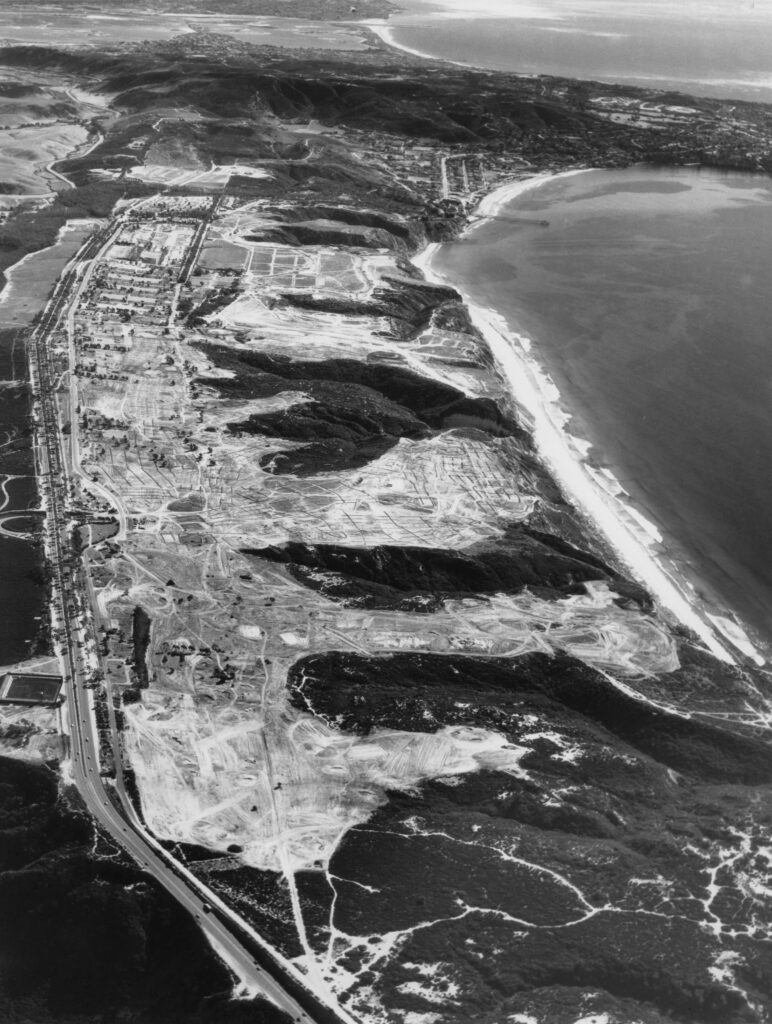
Ariel photo of Torrey Pines GC, from North-to-South, being converted from a raceway in 1956
COURSES CREATED
While the racers enjoyed the mesa’s grounds after the Army left, their days were numbered from the start. In 1950, the city signed a contract with prolific California architect William P. Bell to design 18 holes. Sadly, Bell died in 1954 before the work began, and it was his son, William Francis Bell, who took over and convinced the city to allow for two courses. The South Course opened on June 19, 1957, with the North Course following several months later.
Widely known is that accomplished architect Rees Jones, the so-called “Open Doctor,” reworked much of the South Course in the early 2000s ahead of the first U.S. Open played at Torrey Pines in 2008. Less publicized is the extensive remake effort by hometown hero and three-time major winner and SoCal Golf Hall of Famer Billy Casper, along with architect David Rainville, in the early ’70s — after Jack Nicklaus had interviewed for the work and basically wanted to bulldoze all of it and start over.
Casper and Rainville spent the better part of four years redoing all the tees, bunkers and greens over the 36 holes. One bit of trivia: The only body of water on the interior of Torrey Pines is the pond at the South’s 18th green, and it was Rainville who installed it after the Tour said the par 5 needed to be toughened up. To this day, the water provides the risk to a possible eagle reward on arguably one of the most exciting finishing holes in pro golf.
That the facility is named Torrey Pines is a bit ironic, because early pictures of the courses show a starkly barren landscape with little vegetation. It is true, however, that the Torrey pine tree, named after a botanist who discovered it in the 1850s, grows in only two places in North America — the Torrey Mesa and on Santa Rosa Island off the Santa Barbara coast.
It’s against the law to cut down a Torrey, but they can be transplanted, and it was reported that 30 were successfully moved in Jones’ original redo. For better or worse, the courses have lost, to storms or disease, hundreds of other trees, including a lot of eucalyptus that weren’t prevalent in Southern California until the railroad companies planted them.
THE PROS MOVE IN
The San Diego Open was inaugurated in 1952, and the likes of Arnold Palmer and Gary Player cashed the modest winner’s checks. But the city’s sports movers and shakers yearned for more stature and exposure, and the Century Club of San Diego — so named because every member joined for $100 — was formed in 1961 to do that job.
First, Singing Hills owner Steve Horrell, a member of the SoCal Golf Hall of Fame, got the city to not only subsidize the tournament with a hotel tax but also host the San Diego Open at Torrey Pines without charging anything. Then, inspired by other West Coast tournaments attracting big-name celebrities Bob Hope and Bing Crosby, numerous Century Club leaders targeted singer and entertainer Andy Williams to be their headliner. They pulled it off. The purse doubled in one year, the tournament got a regular TV spot and for two decades Williams attracted celebrities to the pro-am and performed, with Hope, every year at a party on the eve of the tournament.
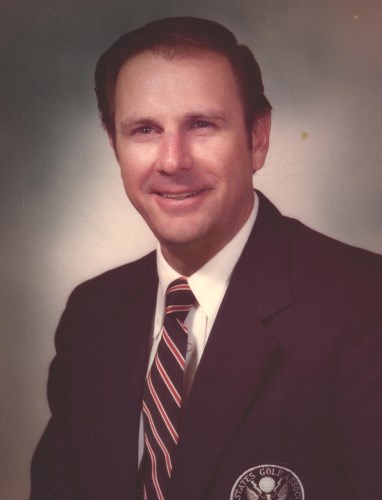
Steve Horrell (Socal Golf Hall of Fame, Class of 2025) was instrumental in bringing the PGA Tour, Andy Williams and the U.S. Open to Torrey Pines GC.
“I think it worked out in spades,” Horrell said in a 2012 interview with the San Diego Union-Tribune. “It brought tremendous attention to San Diego during those long winter months, and this was a long time before we got a Super Bowl.”
Having served on the USGA Executive Committee, Horrell was a tremendous resource and booster when a group of San Diego businesspeople came together to convince the USGA to stage the first U.S. Open at Torrey Pines.
The annual tournament did go through some lean years in the 1980s, but with the arrival of Buick as the sponsor in 1992, the outlook brightened. Hometown star Phil Mickelson won the first of his three Buick Invitationals in 1993 and set off a long run of big-name winners — none more impactful than Tiger Woods.
Woods fell in love with Torrey Pines when his father took him to his first PGA Tour event there, and his first victory on the grounds came in the Junior World Championships. In 1999, Woods won the first of his seven regular PGA Tour titles there, and it was joked that the courses should be renamed “Tiger” Pines. That sentiment only grew stronger when Woods produced one of the greatest victories in major championship history, beating Rocco Mediate in a U.S. Open Monday playoff while playing on a fractured leg.
It seems only fitting that Torrey Pines is the setting for what will forever be the most replayed moment of Woods’ career — his Sunday birdie putt and the roar on the 72nd hole to force the playoff.
Torrey Pines has proved to be a loyal friend to players through the years. Jon Rahm was only 22 when he captured his first PGA Tour title in the 2017 Farmers Insurance Open. The Spaniard then picked the sandy red bluffs near Torrey to get engaged, and later seized a major title on Torrey South in the 2021 U.S. Open. That’s some beautiful karma right there.
THE AMATEURS ARRIVE
While thousands of high school and junior golfers have competed at Torrey Pines, and the facility regularly hosts the San Diego City Championships, the finest amateurs who played there did so during the years of a beloved qualifier for the PGA Tour event. That disappeared in the early 2010s, and there have only been a couple of sizable amateur tournaments otherwise.
In 2003, the SCGA Amateur Championship was played at Torrey Pines for the first and only time until now, and the winner was Roy Moon, a rising junior at UCLA who overtook defending SCGA champ Nico Bollini, from rival USC.
The SCGA and NCGA moved the California Amateur Championship away from Pebble Beach starting in 2006, and amid the COVID-19 pandemic, Torrey Pines hosted the 2020 edition, with San Diego native and Pepperdine star Joey Vrzich taking the title.
This summer, strong fields will take on Torrey Pines once again in the SCGA Amateur and SCGA Women’s Amateur. Last year, there was plenty of buzz surrounding the men’s champion Jaden Soong, of Burbank, who, at 14 years old, became the youngest winner of the historic tournament at The Saticoy Club. Soong, now 15, backed that up during a sensational freshman high school season, winning the CIF state golf title with a 62 at Poppy Hills.
Torrey Pines will serve as a first-time venue for the SCGA Women’s Amateur Championship, which boasts its own impressive history with past winners like Andrea Lee (2015, 2017) and Lilia Vu (2016).
For a property with such a full and fascinating history, it should come as no surprise that Torrey Pines continues to add chapters every year, 2025 notwithstanding.
FOR WHOM THE BELLS TOLL
The opening of the Torrey Pines Golf Courses in 1957 had to be one of the most bittersweet moments in the career of golf course architect William Francis Bell. Years earlier, his father, William Park Bell, had envisioned the layout on the La Jolla bluffs that were once home to the U.S. Army’s Camp Callan. There would be few sites in either of their lives that would present a more spectacular canvas.
But the senior Bell died of a heart attack at the age of 67 in 1953, and his son, widely known as Billy Bell Jr., was entrusted with carrying out the dream for the municipal courses that would eventually become recognized worldwide for hosting PGA Tour events and major championships.
Torrey Pines is arguably the Bells’ most notable course because of its stature, but as the true First Family of golf architecture in California, their contributions to the game here cannot be lauded enough, even if they never seemed to get the same recognition as some of the noted designers on the East Coast.
“Two true masters of golf design,” said fellow golf architect and California native Todd Eckenrode upon the Bells’ induction into the SoCal Golf Hall of Fame in 2017.
The Bells are credited with designing or redesigning more than 300 courses in 10 states — a large portion of them in California. Indeed, if you are a golfer in Southern California, it’s highly likely you’ve played a Bell course, and that’s part of the beauty of their work — their designs ranged from high-end country clubs to municipal courses that still serve millions of players.
Among the original works of William Park Sr. are Rancho Park, Brookside, Balboa Park, Hacienda, Woodland Hills and La Jolla.
Beyond his work at Torrey Pines, Billy Bell Jr., who died in 1984, carried on his father’s legacy with designs of Industry Hills, Sandpiper, Los Verdes, Bermuda Dunes, Newport Beach and Malibu.



